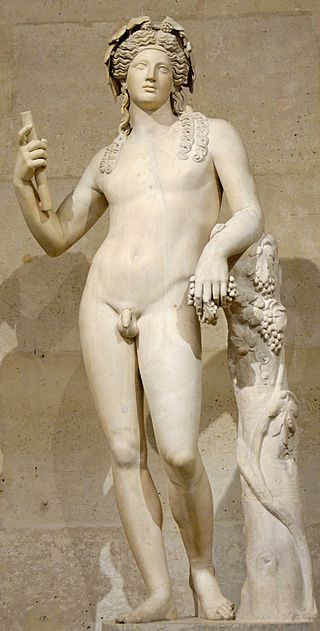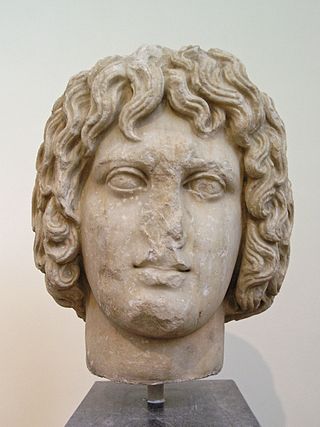
In ancient Greek religion and mythology, Demeter is the Olympian goddess of the harvest and agriculture, presiding over crops, grains, food, and the fertility of the earth. Although Demeter is mostly known as a grain goddess, she also appeared as a goddess of health, birth, and marriage, and had connections to the Underworld. She is also called Deo. In Greek tradition, Demeter is the second child of the Titans Rhea and Cronus, and sister to Hestia, Hera, Hades, Poseidon, and Zeus. Like her other siblings except Zeus, she was swallowed by her father as an infant and rescued by Zeus.

The Erinyes, also known as the Eumenides and commonly known in English as the Furies, are chthonic goddesses of vengeance in ancient Greek religion and mythology. A formulaic oath in the Iliad invokes them as "the Erinyes, that under earth take vengeance on men, whosoever hath sworn a false oath". Walter Burkert suggests that they are "an embodiment of the act of self-cursing contained in the oath". They correspond to the Dirae in Roman mythology. The Roman writer Maurus Servius Honoratus wrote that they are called "Eumenides" in hell, "Furiae" on Earth, and "Dirae" in heaven. Erinyes are akin to some other Greek deities, called Poenai.

Hades, in the ancient Greek religion and mythology, is the god of the dead and the king of the underworld, with which his name became synonymous. Hades was the eldest son of Cronus and Rhea, although this also made him the last son to be regurgitated by his father. He and his brothers, Zeus and Poseidon, defeated their father's generation of gods, the Titans, and claimed joint rulership over the cosmos. Hades received the underworld, Zeus the sky, and Poseidon the sea, with the solid earth available to all three concurrently. In artistic depictions, Hades is typically portrayed holding a bident and wearing his helm with Cerberus, the three-headed guard-dog of the underworld, standing at his side.
Hecate is a goddess in ancient Greek religion and mythology, most often shown holding a pair of torches, a key, or snakes, or accompanied by dogs, and in later periods depicted as three-formed or triple-bodied. She is variously associated with crossroads, night, light, magic, protection from witchcraft, drugs, and the Moon. Her earliest appearance in literature was in Hesiod's Theogony in the 8th century BCE as a goddess of great honour with domains in sky, earth, and sea. She had popular followings amongst the witches of Thessaly, and an important sanctuary among the Carians of Asia Minor in Lagina. Her oldest known representation was found in Selinunte, in Sicily.

In ancient Greek mythology and religion, Leto is a goddess and the mother of Apollo and Artemis. She is the daughter of the Titans Coeus and Phoebe, and the sister of Asteria.

In ancient Greek mythology and religion, Persephone, also called Kore or Cora, is the daughter of Zeus and Demeter. She became the queen of the underworld after her abduction by her uncle Hades, the king of the underworld, who would later also take her into marriage.

In ancient Greek religion and myth, Dionysus is the god of wine-making, orchards and fruit, vegetation, fertility, festivity, insanity, ritual madness, religious ecstasy, and theatre. He was also known as Bacchus by the Greeks for a frenzy he is said to induce called baccheia. As Dionysus Eleutherius, his wine, music, and ecstatic dance free his followers from self-conscious fear and care, and subvert the oppressive restraints of the powerful. His thyrsus, a fennel-stem sceptre, sometimes wound with ivy and dripping with honey, is both a beneficent wand and a weapon used to destroy those who oppose his cult and the freedoms he represents. Those who partake of his mysteries are believed to become possessed and empowered by the god himself.
In ancient Greek religion and mythology, Zagreus was a god sometimes identified with an Orphic Dionysus, a son of Zeus and Persephone, who was dismembered by the Titans and reborn. In the earliest mention of Zagreus, he is paired with Gaia and called the "highest" god, though perhaps only in reference to the gods of the underworld. Aeschylus, however, links Zagreus with Hades, possibly as Hades' son, or as Hades himself. Noting "Hades' identity as Zeus' katachthonios alter ego", Timothy Gantz postulated that Zagreus, originally the son of Hades and Persephone, later merged with the Orphic Dionysus, the son of Zeus and Persephone.
In ancient Greek religion and mythology, Iacchus was a minor deity, of some cultic importance, particularly at Athens and Eleusis in connection with the Eleusinian mysteries, but without any significant mythology. He perhaps originated as the personification of the ritual exclamation Iacche! cried out during the Eleusinian procession from Athens to Eleusis. He was often identified with Dionysus, perhaps because of the resemblance of the names Iacchus and Bacchus, another name for Dionysus. By various accounts he was a son of Demeter, or a son of Persephone, identical with Dionysus Zagreus, or a son of Dionysus.
In Greek mythology, Erebus, or Erebos, is the personification of darkness. In Hesiod's Theogony, he is the offspring of Chaos, and the father of Aether and Hemera (Day) by Nyx (Night); in other Greek cosmogonies, he is the father of Aether, Eros, and Metis, or the first ruler of the gods. In genealogies given by Roman authors, he begets a large progeny of personifications upon Nox, while in an Orphic theogony, he is the offspring of Chronos (Time).

In ancient Greek religion and mythology, Pluto was the ruler of the Greek underworld. The earlier name for the god was Hades, which became more common as the name of the underworld itself. Pluto represents a more positive concept of the god who presides over the afterlife. Ploutōn was frequently conflated with Ploûtos, the Greek god of wealth, because mineral wealth was found underground, and because as a chthonic god Pluto ruled the deep earth that contained the seeds necessary for a bountiful harvest. The name Ploutōn came into widespread usage with the Eleusinian Mysteries, in which Pluto was venerated as both a stern ruler and a loving husband to Persephone. The couple received souls in the afterlife and are invoked together in religious inscriptions, being referred to as Plouton and as Kore respectively. Hades, by contrast, had few temples and religious practices associated with him, and he is portrayed as the dark and violent abductor of Persephone.

Orphism is the name given to a set of religious beliefs and practices originating in the ancient Greek and Hellenistic world, associated with literature ascribed to the mythical poet Orpheus, who descended into the Greek underworld and returned. This type of journey is called a katabasis and is the basis of several hero worships and journeys. Orphics revered Dionysus and Persephone. Orphism has been described as a reform of the earlier Dionysian religion, involving a re-interpretation or re-reading of the myth of Dionysus and a re-ordering of Hesiod's Theogony, based in part on pre-Socratic philosophy.

In Greek mythology, the underworld or Hades is a distinct realm where an individual goes after death. The earliest idea of afterlife in Greek myth is that, at the moment of death, an individual's essence (psyche) is separated from the corpse and transported to the underworld. In early mythology the dead were indiscriminately grouped together and led a shadowy post-existence; however, in later mythology elements of post-mortem judgment began to emerge with good and bad people being separated.
Persephone, the daughter of Zeus and Demeter in Greek mythology, appears in films, works of literature, and in popular culture, both as a goddess character and through the symbolic use of her name. She becomes the queen of the underworld through her abduction by Hades, the god of the underworld. The myth of her abduction represents her dual function as the as chthonic (underworld) and vegetation goddess: a personification of vegetation, which shoots forth in Spring and withdraws into the earth after harvest. Proserpina is the Roman equivalent.
The Orphic Hymns are a collection of eighty-seven ancient Greek hymns addressed to various deities, which are among the few extant works of Orphic literature. They were composed in Asia Minor, most likely around the time of the 2nd or 3rd centuries AD, and were used in the rites of a religious community which existed in the region. The Hymns were in antiquity attributed to the mythical poet Orpheus, and modern scholarship has mostly continued to see the collection as being situated in the Orphic tradition.

In ancient Greek religion and myth, Eubuleus is a god known primarily from devotional inscriptions for mystery religions. The name appears several times in the corpus of the so-called Orphic gold tablets spelled variously, with forms including Euboulos, Eubouleos and Eubolos. It may be an epithet of the central Orphic god, Dionysus or Zagreus, or of Zeus in an unusual association with the Eleusinian Mysteries. Scholars of the late 20th and early 21st centuries have begun to consider Eubuleus independently as "a major god" of the mysteries, based on his prominence in the inscriptional evidence. His depiction in art as a torchbearer suggests that his role was to lead the way back from the Underworld.

The Goddess Girls is a series of children's books written by Joan Holub and Suzanne Williams, published by Simon & Schuster under the Aladdin imprint. The books are based on Greek mythology and depict the younger generation of the Olympian pantheon as privileged tween students attending Mount Olympus Academy (MOA) to develop their divine skills.

Lore Olympus is a romance webcomic created by New Zealand artist Rachel Smythe. The comic is a modern retelling of the relationship between the Greek goddess and god Persephone and Hades. It began publishing weekly on the platform Webtoon in March 2018. On Webtoon, Lore Olympus is currently the most viewed comic, with 1.4 billion views, the second most liked comic, with 72.2 million total likes, just behind My Giant Nerd Boyfriend, which has 73.4 million total likes, and the second most subscribed comic with 6.6 million subscribers, just behind True Beauty, which has 7.5 million subscribers, as of November 2024. The comic has won two Eisner Awards, two Harvey Awards, and two Ringo Awards. It was announced in 2019 that a television adaptation was under development.

Hades II is an upcoming roguelike action role-playing game video game developed and published by Supergiant Games, serving as a sequel to Hades (2020). It was announced in December 2022 and was released in early access in May 2024 for Windows and in October 2024 for macOS, with plans to bring the game to consoles after the early access period. The game follows Melinoë, Princess of the Underworld and sister to Zagreus, the protagonist of the first game. Melinoë aims to defeat Chronos, the Titan of Time, with the aid of other Olympian Gods.

Melinoë is a character in the upcoming video game Hades II. She is the game's protagonist, being the sister of Hades protagonist Zagreus and daughter of its antagonist, Hades. She is a witch, and is able to use magic techniques as well as weapons in combat, tasked with saving her father by killing the Titan Chronos. She is based on the mythological figure of the same name. She has received generally positive reception, with her relationships with Hecate and Nemesis being notable ones in the game's story.














